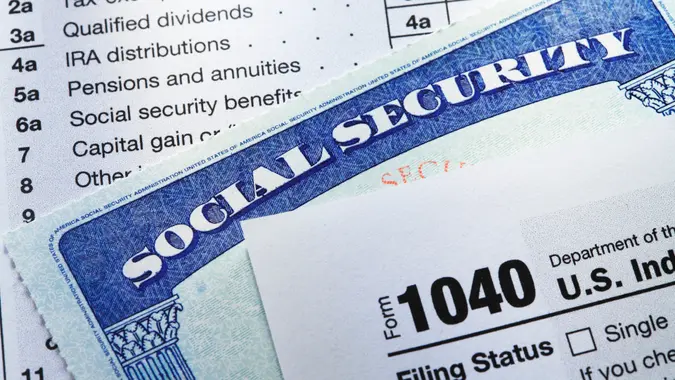Retirement Crisis: Here’s How Much Social Security Anxiety Has Increased Among Boomers

Commitment to Our Readers
GOBankingRates' editorial team is committed to bringing you unbiased reviews and information. We use data-driven methodologies to evaluate financial products and services - our reviews and ratings are not influenced by advertisers. You can read more about our editorial guidelines and our products and services review methodology.

20 Years
Helping You Live Richer

Reviewed
by Experts

Trusted by
Millions of Readers
Since its inception in the mid-1930s, Social Security has existed as a way to supplement retirement income and provide some measure of financial security in one’s later years. In more recent years, however, more people have become concerned about the longevity of the system and the benefits they expect to receive.
In a recent West Health and Gallup poll, Social Security concerns increased significantly for boomers from 2022 to 2024. In fact, 81% of those ages 50 to 61 are either worried or extremely worried about it compared to 72% just two years ago.
These worries aren’t without cause. Social Security is a safety net program, and any potential changes to the system — along with the rising cost of living and relatively small benefits — could heavily impact those who rely on it in their later years.
If you’re anxious about Social Security and how it’s going to look in the future, here’s what you need to know and what you can do to prepare, according to the experts.
Will Social Security End in 2035?
“The major concern that both current retirees and future retirees share is the ability of Social Security to pay out expected benefits beyond the 2035 funding cliff,” said Stephen Kates, CFP, and the principal financial analyst for Annuity.org.
The Social Security Board of Trustees has projected that by 2035 the fund will run out, and there will be a roughly 25% reduction in Social Security benefits.
To keep the program running as intended, certain changes will likely need to be made.
“These changes might include pushing back the retirement age for benefits, increasing the payroll taxes funding the program, or raising the current income cap for payroll taxes,” Kates said.
What Happens If Benefits Decrease?
According to the SSA, the average benefit amount in January of this year was $1,907. While paychecks do tend to increase with the years, a 25% decrease could be significant for those who rely on the program.
“Among Social Security beneficiaries age 65 and older, 37% of men and 42% of women receive 50% or more of their income from Social Security,” said Dana Anspach, founder and CEO of Sensible Money, LLC.
“If Social Security benefits were dramatically reduced, many of these households would plunge into poverty,” Anspach continued. “This would make them more dependent on other forms of welfare. Maintaining a basic standard of living for a large portion of the population will be an expense the government must bear one way or another.”
Positive Changes Could Be on the Horizon
Unsurprisingly, the majority of Americans — 79% — are opposed to program cuts. This adamant opposition could actually be good news for current and future Social Security recipients because it means there’s likely to be more of an effort to shore up the program rather than diminish it, Anspach said.
It probably won’t happen right away, though.
“The last time Social Security was in trouble was 1983, the amendments to the program came in mere months before the program’s potential insolvency, and they were intended to be a 50-year fix. Fifty years takes us to approximately 2033, near the estimated time where the program will once again be in trouble,” Anspach said.
“A series of minor changes can bring the system into balance. But the political impetus to make those changes will likely not happen until the deadline is near,” she continued.
It’s Good To Be Prepared
Whether or not the system is going to experience major changes is still unknown, so it’s wise to start preparing now — just in case. Fortunately, there are several ways to do this.
One of the best ways is to factor the potential benefits reduction into your retirement planning.
“If you want to plan for reduced benefits, when running your retirement projections, use 80% of your future benefit amount beginning in 2035,” Anspach said. “If amendments to the program are successful, you’ll be able to retire a bit earlier, or have more income than you planned. And if benefits are cut, you’ll be prepared.”
Having a flexible plan for your retirement income is another effective strategy.
“The first and best offense for retirement success is planning, saving, and investing for the retirement income you need,” Kates said. “Social Security is and always will be an important part of Americans’ retirement picture, but for most people it represents only a small portion of their retirement income… [P]lan for the three elements of a comprehensive retirement plan: flexibility, growth, and guarantees.”
If the program fails or your benefits get majorly reduced, Kates suggested having other sources of guaranteed income — like pensions or annuities — in its stead.
While you’re at it, plan when you’re going to start collecting benefits carefully. While you might be able to start anytime from the age of 62, you’re likely to get the highest amount if you wait until you’re 70.
The right time to collect depends on you, your health and your retirement goals, however.
“People can prepare ahead of time by getting a Social Security benefit analysis completed to determine the best time to take benefits,” said Chuck Czajka, a certified Social Security claiming strategist and founder of Macro Money Concepts. “There are many claiming strategies available, so having an analysis gives you a better understanding of when to take benefits.”
 Written by
Written by  Edited by
Edited by 























